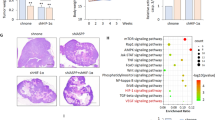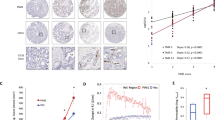Abstract
Background:
Hypoxia-inducible factor-1 (HIF-1) is a master regulator of the transcriptional response to oxygen deprivation and controls genes involved in glycolysis, angiogenesis, migration and invasion. Overexpression of HIF-1α has been demonstrated in many common human cancers.
Methods:
Luciferase reporter gene assay under hypoxia and normoxia was used to demonstrate transcriptional inhibition of HIF-1 by P276-00. Detailed studies such as western blotting, reverse-transcriptase-PCR and immunofluorescence were carried out to elucidate its mechanism of action. Cytotoxic potential of P276-00 under normoxia and hypoxia was determined on prostate cancer cells using CCK-8 assay, and cell-cycle analysis was carried out using flow cytometry. Antiangiogenic activity of P276-00 was demonstrated by migration assay and tube-formation assay. Efficacy study of P276-00 was performed in a PC-3 xenograft model.
Results:
P276-00 inhibits transcriptional activation of HIF-1 under hypoxia. It suppressed hypoxia-mediated nuclear HIF-1α expression, as well as phosphorylation of Akt and 4E-BP1 and abrogated expression of HIF-1-inducible gene viz. vascular endothelial growth factor. Under hypoxia, P276-00 did not exhibit enhanced cytotoxic activity in prostate cancer cells but arrested them in the G2/M phase of the cell cycle. The tubular formation of human umbilical vein endothelial cells and migration of prostate cancer cells were also inhibited by P276-00 in vitro. In addition, it demonstrated significant in vivo efficacy in the PC-3 xenograft model.
Conclusions:
Given its low toxicity profile, its demonstrated antitumor activity and its potential to inhibit the HIF-1 pathway, P276-00 should be considered as antiangiogenic chemotherapy for prostate cancer.
This is a preview of subscription content, access via your institution
Access options
Subscribe to this journal
Receive 4 print issues and online access
$259.00 per year
only $64.75 per issue
Buy this article
- Purchase on Springer Link
- Instant access to full article PDF
Prices may be subject to local taxes which are calculated during checkout









Similar content being viewed by others
References
Sun Y-L, Liu Y-N, Huang Y-T, Pan S-L, Huang D-Y, Guh J-H et al. YC-1 inhibits HIF-1 expression in prostate cancer cells: contribution of Akt/NF-kB signaling to HIF-1α accumulation during hypoxia. Oncogene 2007; 26: 3941–3951.
Akakura N, Kobayashi M, Horiuchi I, Suzuki A, Wang J, Chen J et al. Constitutive expression of hypoxia-inducible factor-1α renders pancreatic cancer cells resistant to apoptosis induced by hypoxia and nutrient deprivation. Cancer Res 2001; 61: 6548–6554.
Zhong H, De Marzo AM, Laughner E, Lim M, Hilton DA, Zagzag D et al. Overexpression of hypoxia-inducible factor 1α in common human cancers and their metastases. Cancer Res 1999; 59: 5830–5835.
Newcomb EW, Lukyanov Y, Schnee T, Ali MA, Lan L, Zagzag D . Noscapine inhibits hypoxia-mediated HIF-1alpha expression and angiogenesis in vitro: a novel function for an old drug. Int J Oncol 2006; 28: 1121–1130.
Sommani P, Yamashita K, Miyoshi T, Tsunemine H, Kodaki T, Mori H et al. Inhibitory effect of 6-Formylpterin on HIF-1α protein accumulation. Biol Pharm Bull 2007; 30: 2181–2184.
Dong-Li Z, Liu L-Z, Shi X, Fang J, Jiang B-H . Benzo[α] pyrene-3,6-dione inhibited VEGF expression through inducing HIF-1α degradation. Biochem Biophys Res Commun 2007; 357: 517–523.
Bilton RL, Wilson WR . Exploiting tumour hypoxia in cancer treatment. Nat Rev Cancer 2003; 4: 437–447.
Zhong H, Chiles K, Feldser D, Laughner E, Hanrahan C, Georgescu MM et al. Modulation of hypoxia-inducible factor 1alpha expression by the epidermal growth factor/ phosphatidylinositol 3-kinase/PTEN/AKT/FRAP pathway in human prostate cancer cells: implications for tumor angiogenesis and therapeutics. Cancer Res 2000; 60: 1541–1545.
Laughner E, Taghavi P, Chiles K, Mahon PC, Semenza GL . HER2 (neu) signaling increases the rate of hypoxia-inducible factor 1alpha (HIF1-alpha) synthesis: novel mechanism for HIF-1-mediated vascular endothelial growth factor expression. Mol Cell Biol 2001; 21: 3995–4004.
Treins C, Giorgetti-Peraldi S, Murdaca J, Semenza GL, Van OE . Insulin stimulates hypoxia-inducible factor 1 through a phosphotidyl 3-kinase/target of rapamycin-dependent signaling pathway. J Biol Chem 2002; 277: 27975–27981.
Joshi KS, Rathos MJ, Joshi RD, Sivakumar M, Mascarenhas M, Kamble S et al. In vitro antitumor properties of a novel cyclin-dependent kinase inhibitor, P276-00-00. Mol Cancer Ther 2007; 6: 918–925.
Joshi KS, Rathos MJ, Mahajan P, Wagh V, Shenoy S, Chile S et al. P276-00-00, a novel cyclin-dependent inhibitor induces G1-G2 arrest, shows antitumor activity on cisplatin-resistant cells and significant in vivo efficacy in tumor models. Mol Cancer Ther 2007; 6: 926–934.
Rapisarda A, Uranchimeg B, Scudiero DA, Selby M, Sausville EA, Shoemaker RH et al. Identification of small molecule inhibitors of hypoxia-inducible factor 1 transcriptional activation pathways. Cancer Res 2002; 62: 4316–4324.
Zundel W, Schindler C, Haas-Kogan D, Koong A, Kaper F, Chen E . Loss of PTEN facilitates HIF-1-mediated gene expression. Genes Dev 2000; 14: 391–396.
Chen EY, Mazure NM, Cooper JA, Giaccia AJ . Hypoxia activates a platelet-derived growth factor receptor/phosphatidylinositol 3-kinase/Akt pathway that results in glycogen synthase kinase-3 inactivation. Cancer Res 2001; 61: 2429–2433.
Hudson CC, Liu M, Chiang GG, Otterness DM, Loomis DC, Kaper F et al. Regulation of hypoxia-inducible factor 1alpha expression and function by the mammalian target of rapamycin. Mol Cell Biol 2002; 22: 7004–7014.
Li M-H, Miao Z-H, Tan W-F, Yue J-M, Zhang X-W, Ding J . Pseudolaric acid B inhibits angiogenesis and reduces hypoxia-inducible factor 1α by promoting proteasome-mediated degradation. Clin Cancer Res 2004; 10: 8266–8274.
Kong D, Park E-J, Stephen AG, Calvani M, Cardellina JH, Monks A et al. Echinomycin, a small-molecule inhibitor of hypoxia-inducible factor-1 DNA-binding activity. Cancer Res 2005; 65: 9047–9055.
Sun X, Kanwar JR, Leung E, Lehnert K, Wang D, Krissansen GW . Gene transfer of antisense hypoxia inducible factor-1α enhances the therapeutic efficacy of cancer immunotherapy. Gene Ther 2001; 8: 638–645.
Zhang Q, Zhang ZF, Rao JY, Sato JD, Brown J, Messadi DV et al. Treatment with siRNA and antisense oligonucleotides targeted to HIF- 1α induced apoptosis in human tongue squamous cell carcinomas. Int J Cancer 2004; 111: 849–857.
Neckers L . Hsp90 inhibitors as novel cancer chemotherapeutic agents. Trends Mol Med 2002; 8: S55–S61.
Mabjeesh NJ, Post DE, Willard MT, Kaur B, Van Meir EG, Simons JW et al. Geldanamycin induces degradation of hypoxia-inducible factor 1α protein via the proteosome pathway in prostate cancer cells. Cancer Res 2002; 62: 2478–2482.
Kurebayashi J, Otsuki T, Kurosumi M, Soga S, Akinga S, Sonoo H . A radicicol derivative, KF58333, inhibits expression of hypoxia-inducible factor-1α and vascular endothelial growth factor, angiogenesis and growth of human breast cancer xenografts. J Cancer Res 2001; 92: 1342–1351.
Welsh SJ, Williams RR, Birmingham A, Newman DJ, Kirkpatrick DL, Powis G . The thioredoxin redox inhibitors 1-methylpropyl 2-imidazolyl disulfide and pleurotin inhibit hypoxia-induced factor 1a and vascular endothelial growth factor formation. Mol Cancer Ther 2003; 2: 235–243.
Tan C, de Noronha RG, Roecker AJ, Pyrzynska B, Khwaja F, Zhang Z et al. Identification of a novel small-molecule inhibitor of the hypoxia inducible factor 1 pathway. Cancer Res 2005; 65: 605–612.
Mabjeesh NJ, Willard MT, Harris WB, Sun HY, Wang R, Thong H et al. Dibenzoylmethane, a natural dietary compound, induces HIF- 1α and increases expression of VEGF. Biochem Biophys Res Commun 2003; 303: 279–286.
Rapisarda A, Uranchimeg B, Sordet O, Pommier Y, Shoemaker RH, Melillo G . Topoisomerase I-mediated inhibition of hypoxia-inducible factor 1: mechanism and therapeutic implications. Cancer Res 2004; 64: 1475–1482.
Yeo EJ, Chun YS, Cho YS, Kim J, Lee J-C, Kim M-S et al. YC-1: a potential anticancer drug targeting hypoxia-inducible factor 1. J Natl Cancer Inst 2003; 95: 516–525.
Welsh S, Williams R, Kirkpatrick L, Paine-Murrieta G, Powis G . Antitumor activity and pharmacodynamic properties of PX-478, an inhibitor of hypoxia-inducible factor-1α. Mol Cancer Ther 2004; 3: 233–244.
Giaccia A, Siim BG, Johnson RS . HIF-1 as a target for drug development. Nat Rev Drug Discov 2003; 2: 803–811.
Semenza GL . Targeting HIF-1 for cancer therapy. Nat Rev Cancer 2003; 3: 721–732.
Powis G, Kirkpatrick L . Hypoxia inducible factor- 1alpha as a cancer drug target. Mol Cancer Ther 2004; 3: 647–654.
Yeo EJ, Chun YS, Park JW . New anticancer strategies targeting HIF-1. Biochem Pharmacol 2004; 68: 1061–1069.
Belozerov VE, Van Meir EG . Hypoxia inducible factor-1: a novel target for cancer therapy. Anticancer Drugs 2005; 16: 901–909.
Escuin D, Kline ER, Giannakakou P . Both microtubule-stabilizing and microtubule-destabilizing drugs inhibit hypoxia-inducible factor-1alpha accumulation and activity by disrupting microtubule function. Cancer Res 2005; 65: 9021–9028.
Wiedmann MW, Caca K . Molecularly targeted therapy for gastrointestinal cancer. Curr Cancer Drug Targets 2005; 5: 171–193.
Generali D, Berruti A, Brizzi MP, Campo L, Bonardi S, Wigfield S et al. Hypoxia-inducible factor-1α expression predicts a poor response to primary chemoendocrine therapy and disease-free survival in primary human breast cancer. Clin Cancer Res 2006; 12: 4562–4568.
Patiar S, Harris AL . Role of hypoxia-inducible factor-1α as a cancer therapy target. Endocr Relat Cancer 2006; 13: 61–75.
Powis G, Kirkpatrick L . Hypoxia inducible factor-1α as a cancer drug target. Mol Cancer Ther 2004; 5: 647–654.
Zhong H, Semenza GL, Simons JW, De Marzo AM . Up-regulation of hypoxia-inducible factor 1alpha is an early event in prostate carcinogenesis. Cancer Detect Prev 2004; 28: 88–93.
Du Z, Fujiyama C, Chen Y, Masaki Z . Expression of hypoxia-inducible factor 1alpha in human normal, benign, and malignant prostate tissue. Chin Med J 2003; 116: 1936–1939.
Fang J, Ding M, Yang L, Liu L-Z, Jiang B-H . PI3K/PTEN/AKT signaling regulates prostate tumor angiogenesis. Cell Signal 2007; 19: 2487–2497.
Karni R, Dor Y, Keshet E, Meyuhas O, Levitzki A . Activated pp60c-Src leads to elevated hypoxia-inducible factor (HIF)-1α expression under normoxia. J Biol Chem 2002; 277: 42919–42925.
Lou J, Zhou X, Weng Q, Wang D-d, Xia Q, Hu Y et al. XQ2, a novel TPZ derivative, induced G2/M arrest and apoptosis under hypoxia in non-small cell lung cancer cells. Biosci Biotechnol Biochem 2010; 74: 1181–1187.
Pauli RM, Strauss BS . Proliferation of human peripheral lymphocytes. Characteristics of cells once stimulated or restimulated by concanavalin A. Exp Cell Res 1973; 82: 357–366.
Acknowledgements
The study has been supported and carried out at Piramal Life Sciences, Goregaon, Mumbai, India. We extend our thanks for the support.
Author information
Authors and Affiliations
Corresponding author
Ethics declarations
Competing interests
The authors declare no conflict of interest.
Rights and permissions
About this article
Cite this article
Manohar, S., Padgaonkar, A., Jalota-Badhwar, A. et al. Cyclin-dependent kinase inhibitor, P276-00, inhibits HIF-1α and induces G2/M arrest under hypoxia in prostate cancer cells. Prostate Cancer Prostatic Dis 15, 15–27 (2012). https://doi.org/10.1038/pcan.2011.51
Received:
Revised:
Accepted:
Published:
Issue Date:
DOI: https://doi.org/10.1038/pcan.2011.51
Keywords
This article is cited by
-
Exploring the potential of chromone scaffold compounds in cancer therapy: targeting key kinase pathways
Medicinal Chemistry Research (2023)
-
P276-00, a cyclin-dependent kinase inhibitor, modulates cell cycle and induces apoptosis in vitro and in vivo in mantle cell lymphoma cell lines
Molecular Cancer (2012)
-
Flavone for prostate cancer
Nature India (2012)



